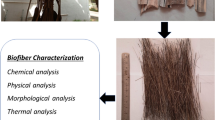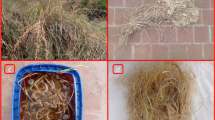Abstract
To include sustainability into their products, composite industries use natural resources as raw materials. This study explores the isolation and characterization of novel Dypsis lutescens peduncle fiber (DLPF) extracted from the peduncle of Dypsis lutescens an agro-waste. The thermo-mechanical and chemical characteristics of DLPF were comparable to other eco-friendly fibers utilized as firming material in polymer composites. Towards favoring the composite industry in deciding the use of DLPF as firming material in polymer composite cellulose composition (51.11 wt%), least wax (0.31 wt%), minimum density (1.35 g/cm3), greater crystallinity index (49%), tensile strength (122–198 MPa), and Young’s modulus (2.3–5.8 GPa) were assessed. The thermogravimetric (TGA-DTG) and differential scanning calorimetry (DSC) analysis revealed the thermal stability (224 °C), endothermic, and exothermic characteristics of DLPF with increase in temperature correspondingly. The prevalence of key operational clusters in the DLPF was recognized through Fourier transform infrared spectroscopy (FTIR) spectrum. The exterior texture of DLPF was captured through scanning electron microscope (SEM) to understand the interference characteristics of the DLPF with matrix when utilized as firming material in polymer composites. The assessed mechanical features, thermal characteristics, and chemical nature of DLPF give scope that it can be employed as a firming material in polymer composites employed in lesser weight structures.
Graphical Abstract







Similar content being viewed by others
Data availability
This is an ongoing research work and hence the data cannot be shared at this moment.
References
Soni A, Das PK, Yusuf M, Ridha S, Kamyab H, Chelliapan S, Kirpichnikova I, Mussa ZH (2023) Valorization of post-consumers plastics and agro-waste in sustainable polymeric composites for tribological applications, waste biomass valorization. https://doi.org/10.1007/s12649-023-02103-w
Soni A, Das PK, Yusuf M, Kamyab H, Chelliapan S (2022) Development of sand-plastic composites as floor tiles using silica sand and recycled thermoplastics: a sustainable approach for cleaner production. Sci Rep 12:18921. https://doi.org/10.1038/s41598-022-19635-1
Chakravarthy S, Madhu K, Raju JSN, Shariff Md J (2020) Characterization of novel natural cellulosic fiber extracted from the stem of Cissus vitiginea plant. Int J Biol Macromol 161:1358–1370. https://doi.org/10.1016/j.ijbiomac.2020.07.230
Chakkour M, Ould Moussa M, Khay I, Balli M, Ben Zineb T (2023) Towards widespread properties of cellulosic fibers composites: a comprehensive review. J Reinf Plast Compos 42(5-6):222–263. https://doi.org/10.1177/07316844221112974
Yang S, Jiang J, Ye H, Sheng Y, Zhou Y, Foong SY, Sonne C, Chong WWF, Lam SS, Xie Y, Li J, Ge S (2023) Transforming municipal cotton waste into a multilayer fibre biocomposite with high strength. Environ Res 218:114967. https://doi.org/10.1016/j.envres.2022.114967
Senthamaraikannan P, Saravanakumar SS (2023) Evaluation of characteristic features of untreated and alkali-treated cellulosic plant fibers from Mucuna atropurpurea for polymer composite reinforcement, Biomass Convers. Biorefin. 13:11295–11309. https://doi.org/10.1007/s13399-022-03736-y
Soni A, Das PK, Yusuf M, Ridha S, Kamyab H, Alam MA, Masood F, Chelliapan S, Ubaidullah M, Pandit B, Prakash C (2023) Synergy of silica sand and waste plastics as thermoplastic composites on abrasive wear characteristics under conditions of different loads and sliding speeds. Chemosphere. 323:138233. https://doi.org/10.1016/j.chemosphere.2023.138233
Siva R, Valarmathi TN, Palanikumar K, Antony VS (2020) Study on a novel natural cellulosic fiber from Kigelia africana fruit: characterization and analysis. Carbohydr Polym 244:e116494. https://doi.org/10.1016/j.carbpol.2020.116494
Sivakumar NS, Thangarasu VS, Soundararajan R, Jayaseelan V (2023) Mechanical and machining behavior of betel nut fiber/leather/chitin-toughened epoxy hybrid composite. Biomass Convers Biorefin 13:4365–4372. https://doi.org/10.1007/s13399-022-02994-0
Selvan MTGA, Binoj JS, Mansingh BB, Sajin JAB (2023) Physico-chemical properties of alkali treated cellulosic fibers from fragrant screw pine prop Root. J Nat Fibers 20(1):e2129897. https://doi.org/10.1080/15440478.2022.2129897
Raju JSN, Depoures MV, Kumaran P (2021) Comprehensive characterization of raw and alkali (NaOH) treated natural fibers from Symphirema involucratum stem. Int J Biol Macromol 186:886–896. https://doi.org/10.1016/j.ijbiomac.2021.07.061
Mohan Prasad M, Sutharsan SM, Ganesan K, Ramesh Babu N, Maridurai T (2022) Role of sugarcane bagasse biogenic silica on cellulosic Opuntia dillenii fibre-reinforced epoxy resin biocomposite: mechanical, thermal and laminar shear strength properties Biomass Conv. Bioref. https://doi.org/10.1007/s13399-021-02154-w
Li T, Zhang Y, Jin Y, Bao L, Dong L, Zheng Y, Xia J, Jiang L, Kang Y, Wang J (2023) Thermoplastic and biodegradable sugarcane lignin-based biocomposites prepared via a wholly solvent-free method. J Clean Prod 386:e135834. https://doi.org/10.1016/j.jclepro.2022.135834
Zhou S, Xia L, Zhang K, Zhuan F, Wang Y, Zhang Q, Zhai L, Mao Y, Xu W (2021) Titanium dioxide decorated natural cellulosic Juncus effusus fiber for highly efficient photo-degradation towards dyes. Carbohydr Polym 232:e115830. https://doi.org/10.1016/j.carbpol.2020.115830
Segal L, Creely J. J, Martin Jr A. E, Conrad C. M (1959) An empirical method for estimating the degree of crystallinity of native cellulose using the X-ray diffractometer. Text Res J 29:786-794. https://doi.org/10.1177/004051755902901003
Njoku CE, Omotoyinbo JA, Alaneme KK, Daramola MO (2022) Characterization of Urena lobata fibers after alkaline treatment for use in polymer composites. J Nat Fibers 19(2):485–496. https://doi.org/10.1080/15440478.2020.1745127
Bharath KN, Binoj JS, Mansingh BB, Manjunath GB, Raghu GV, Siengchin S, Sanjay MR (2023) Effect of stacking sequence and interfacial analysis of biomass sheep wool/glass fiber reinforced epoxy biocomposites. Biomass Convers Biorefin. https://doi.org/10.1007/s13399-023-03918-2
Khan A, Vijay R, Lenin Singaravelu D, Sanjay MR, Siengchin S, Jawaid M, Alamry KA, Asiri AM (2022) Extraction and characterization of natural fibers from Citrullus lanatus climber. J Nat Fibers 19:621–629. https://doi.org/10.1080/15440478.2020.1758281
Ding L, Han X, Cao L, Chen Y, Ling Z, Han J, He S, Jiang S (2022) Characterization of natural fiber from manau rattan (Calamus manan) as a potential reinforcement for polymer-based composites. J Bioresour Bioprod 7:190–200. https://doi.org/10.1016/j.jobab.2021.11.002
Amutha K, Sudha A, Saravanan D (2022) Characterization of natural fibers extracted from banana inflorescence bracts. J Nat Fibers 19:872–881. https://doi.org/10.1080/15440478.2020.1764437
Poomathi S, Roji SSS (2022) Experimental investigations on Palmyra sprout fiber and biosilica-toughened epoxy bio composite. Biomass Conv Bioref. https://doi.org/10.1007/s13399-022-02867-6
Aziz K, El Achaby M, Mamouni R, Saffaj N, Aziz F (2023) A novel hydrogel beads based copper-doped Cerastoderma edule shells@Alginate biocomposite for highly fungicide sorption from aqueous medium. Chemosphere. 311(1):e136932. https://doi.org/10.1016/j.chemosphere.2022.136932
Thooyavan Y, Kumaraswamidhas LA, Edwin Raj R, Binoj JS, Brailson Mansingh B (2022) Effect of combined micro and nano SiC particles addition on mechanical, wear and moisture absorption features of basalt bidirectional mat/vinyl ester composites, Polym. Compos. 43(5):2574–2583. https://doi.org/10.1002/pc.26557
French AD (2014) Idealized powder diffraction patterns for cellulose polymorphs. Cellulose 21:885–896. https://doi.org/10.1007/s10570-013-0030-4
Narayanasamy P, Balasundar P, Senthil S, Sanjay MR, Siengchin S, Khan A, Abdullah MA (2020) Characterization of a novel natural cellulosic fiber from Calotropis gigantea fruit bunch for ecofriendly polymer composites. Int J Biol Macromol 150:793–801. https://doi.org/10.1016/j.ijbiomac.2020.02.134
Lendvai L, Omastova M, Patnaik A, Dogossy G, Singh T (2023) Valorization of waste wood flour and rice husk in poly(lactic acid)-based hybrid biocomposites. J Polym Environ 31:541–551. https://doi.org/10.1007/s10924-022-02633-9
Sabarinathan P, Annamalai VE, Rajkumar K, Vishal K, Dhinakaran V (2022) Synthesis and characterization of randomly oriented silane-grafted novel bio-cellulosic fish tail palm fiber–reinforced vinyl ester composite. Biomass Conv Bioref. https://doi.org/10.1007/s13399-022-02459-4
Prabhu P, Jayabalakrishnan D, Balaji V, Bhaskar K, Maridurai T, Arun Prakash VR (2022) Mechanical, tribology, dielectric, thermal conductivity, and water absorption behaviour of Caryota urens woven fibre-reinforced coconut husk biochar toughened wood-plastic composite. Biomass Conv Bioref. https://doi.org/10.1007/s13399-021-02177-3
Khalili H, Bahloul A, Ablouh E-H, Sehaqui H, Kassab Z, Hassani F-ZSA, El Achaby M (2023) Starch biocomposites based on cellulose microfibers and nanocrystals extracted from alfa fibers (Stipa tenacissima). Int J Biol Macromol 226:345–356. https://doi.org/10.1016/j.ijbiomac.2022.11.313
Anand PB, Lakshmikanthan A, Chandrashekarappa MPG, Selvan CP, Pimenov DY, Giasin K (2022) Experimental investigation of effect of fiber length on mechanical, wear, and morphological behavior of silane-treated pineapple leaf fiber reinforced polymer composites fibers. 10(7):56–69. https://doi.org/10.3390/fib10070056
Ilaiya Perumal C, Sarala R (2020) Characterization of a new natural cellulosic fiber extracted from Derris scandens stem. Int J Biol Macromol 165:2303–2313. https://doi.org/10.1016/j.ijbiomac.2020.10.086
Raja T, Devarajan Y (2023) Effective utilization of fibre extracted from the waste neem tree twigs—a step towards sustainable practices. Biomass Convers Biorefin. https://doi.org/10.1007/s13399-023-04133-9
Balda S, Sharma A, Capalash N, Sharma P (2021) Banana fibre: a natural and sustainable bioresource for eco-friendly applications. Clean Techn Environ Policy 23:1389–1401. https://doi.org/10.1007/s10098-021-02041-y
French AD (2020) Increment in evolution of cellulose crystallinity analysis. Cellulose 27:5445–5448. https://doi.org/10.1007/s10570-020-03172-z
Palaniyappan S, Sivakumar NK, Sekar V (2023) Sustainable approach to the revalorization of crab shell waste in polymeric filament extrusion for 3D printing applications. Biomass Convers Biorefin. https://doi.org/10.1007/s13399-023-03795-9
Gryczak M, Bernadin AM (2021) Development and characterization of sustainable agglomerated composites formulated from castor polyurethane resin and reinforced with rice husk. Clean Techn Environ Policy 23:1655–1662. https://doi.org/10.1007/s10098-021-02036-9
Tadele D, Roy P, Defersha F, Misra M, Mohanty AK (2020) A comparative life-cycle assessment of talc- and biochar-reinforced composites for lightweight automotive parts. Clean Techn Environ Policy 22:639–649. https://doi.org/10.1007/s10098-019-01807-9
Author information
Authors and Affiliations
Contributions
ASFB: investigation (lead), resources, and supporting. NRP: resources and supporting. BBM: writing—original draft. RD: resources and supporting. AAMMS: investigation and writing—original draft. JSB: writing—original draft and reviewing.
Corresponding author
Ethics declarations
Ethics approval and consent to participate
All the authors demonstrate that they have adhered to the accepted ethical standards of a genuine research study. Also, individual consent from all the authors was undertaken to publish the data prior submitting to journal.
Consent for publication
Written formal consent ensures that the publisher has the author’s permission to publish research findings.
Competing interests
The authors declare no competing interests.
Additional information
Publisher’s note
Springer Nature remains neutral with regard to jurisdictional claims in published maps and institutional affiliations.
Highlights
• Biowaste Dypsis lutescens peduncle fiber (DLPF) characterized for probable reinforcement.
• Low wax (0.31 wt%) and density (1.35 g/cm3) of DLPF ensure good bonding features.
• Thermal studies (TGA and DSC) confirm thermal stability of DLPF till 224 °C.
• Specific properties of DLPF suit as reinforcement for bio-composite applications.
Rights and permissions
Springer Nature or its licensor (e.g. a society or other partner) holds exclusive rights to this article under a publishing agreement with the author(s) or other rightsholder(s); author self-archiving of the accepted manuscript version of this article is solely governed by the terms of such publishing agreement and applicable law.
About this article
Cite this article
Britto, A.S.F., Prabha, N.R., Mansingh, B.B. et al. Extraction and characterization of Dypsis lutescens peduncle fiber: agro-waste to probable reinforcement in biocomposites—a sustainable approach. Biomass Conv. Bioref. (2023). https://doi.org/10.1007/s13399-023-04950-y
Received:
Revised:
Accepted:
Published:
DOI: https://doi.org/10.1007/s13399-023-04950-y




